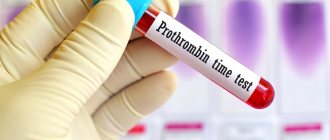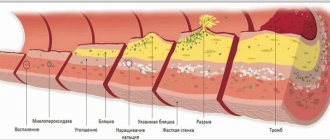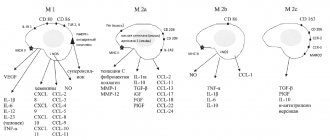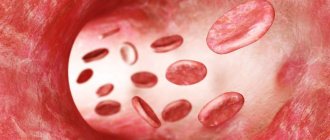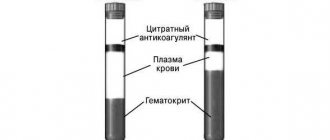It is blood that is the real “river of life” in the human body, and almost all processes occurring in the body depend on its normal composition.
The main problem that arises when the composition of this fluid environment of the body is disturbed is blood thickening, which leads to the work of many organs and systems in emergency mode. The most life-threatening consequences in such cases are heart attacks and strokes, which are a consequence of increased thrombus formation.
A little about the main functions of blood
The main function of red blood cells is to transport oxygen to the cells of the whole body.
All the tasks that the body sets for the blood are carried out thanks to the coordinated work of its following components:
- plasma – the liquid non-cellular part of blood;
- erythrocytes, platelets, represented by various elements leukocytes - cell mass (or suspended formed elements of blood);
- ions of various micro- and macroelements, enzymes, hormones and other substances entering the blood.
All of the above components perform the following functions:
- transport substances necessary for life (hormones, enzymes, nutrients and “fuel” elements) and remove “waste” materials accumulated in the blood (carbon dioxide, etc.);
- regulate the flow of water and electrolytes into the tissue;
- ensure the functioning of the immune system when pathogenic objects (microorganisms, own mutated cells) enter the blood.
A parameter such as blood thickness is determined by the balance between the liquid (plasma) and cellular (formed elements) part of the blood. It is this property that allows it to penetrate the smallest vessels and capillaries. This ensures the necessary delivery of blood to all tissues of the body.
Anemia (or anemia) is accompanied by a decrease in those blood parameters that relate to red blood cells. It is these red cells that carry oxygen, and if their production is disrupted, hypoxia of the tissues of all body systems develops.
Hyperthickness syndrome
Thickening (or hyperviscosity of the blood) worsens the rheological properties of this part of the body. This means that blood begins to move (flow) more slowly through the blood vessels. The following parameters can cause such violations:
- A joint increase in the density of both plasma and blood.
- An increase in hematocrit due to a violation of the ratio of formed elements to the volume of blood as a whole. Normally, the hematocrit is 4:6 (4 – formed part, 6 – plasma). For men, this figure is always slightly higher.
- Increased hemoglobin levels.
- Reduced elasticity and ability to deform red blood cells.
- Increasing the level of a protein responsible for blood clotting, fibrinogen.
- Increased sticking of red blood cells (or aggregation).
- Increased levels of paraproteins - pathological proteins released into the blood during diseases such as myeloma.
Blood density indicators are measured using a viscometer, which compares the speed of movement of this medium in relation to the same indicator of distilled water. Measurements are performed under the same conditions (i.e., same volume and temperature). Normally, blood flows 4-5 times slower than water, and blood viscosity is 1.050-1.064 g/ml.
Blood thickens due to the following factors:
- fermentopathy – conditions leading to incomplete breakdown of food, contamination of the blood with under-oxidized substances that provoke its acidification;
- disorders in the functioning of the liver, which are provoked by an insufficient supply of vitamins, minerals, decreased levels of enzymes and hormones, consumption of large amounts of salty, sweet, smoked, meat and canned foods;
- imbalance between blood cell mass and plasma in tumors of hematopoietic tissue (for example, leukemia);
- dehydration – loss of the liquid part of plasma due to excessive exercise, temperature exposure, taking diuretics, diarrhea, vomiting and poor absorption of water.
Treatment
The easiest first step for any potential patient is to normalize their diet and lifestyle. This includes immediately increasing the amount of fluid in your diet.
It is advisable that it be simple clean water. Even a healthy person needs to drink from two to three liters per day to provide all systems with it. Moreover, in this situation we are talking specifically about water, and not about tea, coffee or other liquids. A simple change in drinking habits in most situations helps to reduce and bring viscosity levels to normal. Among the reasons for thickening, experts also indicate a deficiency of substances:
- proteins;
- amino acids;
- fatty acids.
To replenish them, it is recommended to include in your daily diet:
- seaweed;
- chicken eggs;
- lean meats;
- fish;
- milk;
- flaxseed and olive oil.
These products should be on the menu constantly. At the same time, it is worth reducing the amount of sugar, spicy seasonings, fatty meats, and lard.
If you stick to such a diet constantly, you may never know what blood viscosity is for the rest of your life. Active sports play a big role. You don't have to join a gym.
For a modern person, most of whose life is spent in a static state, sometimes just a regular walk for 1-2 hours at least 2-3 times a week is enough. This approach to your health will strengthen all body systems.
In case of serious problems, a specialist will recommend how to treat thick viscous blood. To improve the condition, specialized medications can be used. Including ascorbic acid, heparin, magnecard, thrombo ACC, lospirin. A wide selection of specialized medicines are available for sale. But you should not resort to self-medication, given the danger of consequences. The course of therapy is prescribed by the attending physician after diagnostic studies.
What are the signs that indicate that the blood is thick?
Headache and dizziness may be manifestations of blood thickening.
When the blood thickens, the following changes in well-being are felt:
- aching headaches;
- dizziness with loss of coordination of movement;
- muscle weakness;
- decreased tolerance to stress;
- noise in ears;
- fainting conditions;
- dry skin;
- paresthesia in the legs and arms: crawling, tingling, burning, numbness;
- blue discoloration (cyanosis) of the mucous membranes of the mouth, eyes and areas of the skin;
- increased sensitivity to low temperatures;
- drowsiness;
- frequent yawning;
- heaviness and pain in the legs;
- anxiety;
- depression;
- sleep disorders;
- absent-mindedness;
- slow bleeding after cuts;
- constipation and flatulence (sometimes).
When the blood is thick, women tend to have repeated miscarriages. In addition, blood tests often reveal elevated hemoglobin levels. Patients with blood hyperviscosity syndrome often exhibit one of the following syndromes:
- chronic fatigue,
- irritable bowel,
- candidiasis.
Symptoms
The first sign of the disease is severe swelling that rises from the toes along the ankle joint to the lower leg and thigh. For this reason:
- the limb loses its natural shape and becomes like a column;
- the skin becomes stretched, causing the patient unpleasant pain;
- joints become less mobile;
- the pattern of veins on the limbs disappears, the skin noticeably becomes rougher and darker, and its structure becomes similar to an orange peel.
Signs of lymphostasis at different stages of the disease
Depending on the severity of symptoms, the following stages of the disease are distinguished:
- at the first stage, edema occurs only under the influence of external unfavorable factors: prolonged sitting or standing, increased volumes of water drunk, heat, etc. More often, edematous phenomena appear in the late afternoon;
- the second stage of lymphedema is said to occur when swelling occurs more frequently and the patient begins to feel severe pain and heaviness in the legs. When you press on the skin, a noticeable dent remains, which gradually levels out. The patient’s body weight increases due to edema, and the skin noticeably becomes rougher, losing its natural elasticity;
- at the third stage, the joints of the limb become immobilized, it loses its natural shape, and signs of trophic ulcers appear on the skin, which can lead to sepsis and the gradual development of tissue necrosis.
Complications
In the absence of medical control and treatment, lymphedema can cause:
- hyperkeratosis;
- skin fistulas;
- tissue phlegmon;
- erysipelas, etc.
With a long course of the disease, signs of lymphangiosarcoma may appear.
Are you experiencing symptoms of lymphedema?
Only a doctor can accurately diagnose the disease. Don't delay your consultation - call
Why does blood thicken?
Hyperviscosity of the blood can be caused by hereditary or genetic reasons:
- there is a history of predisposition to the formation of blood clots;
- the history reveals cases of unjustified miscarriages.
Excessive blood thickening can be caused not only by hereditary causes, but also by external or internal factors:
- Aging. In all people, with age, the blood becomes thicker, and the vessels become more rigid and calcified.
- Smoking. Substances contained in tobacco smoke thicken the blood and increase the risk of blood clots.
- Overweight. Metabolic disorders in obesity lead to atherosclerotic changes in blood vessels and blood composition. As a result, it becomes more viscous.
- Alcohol abuse. Alcohol not only speeds up the removal of fluid from the body, but also thickens the blood.
- Dehydration. With a lack of water, the vessels begin to narrow, and this moment slows down the flow of blood, leading to its thickening.
- Prolonged bed rest. Conditions after long-term operations, illness or injury may lead to prolonged bed rest, which disrupts blood flow in organs and areas of the body. Stagnation in blood circulation leads to blood thickening.
- Pregnancy. The growth of the uterus as the fetus matures causes compression of the pelvic veins and leads to blood stagnation, which can result in the formation of blood clots.
- Use of contraceptives or hormone-based medications. This effect on the blood often leads to an increased risk of thrombosis and requires mandatory monitoring of the blood coagulation system while taking the drug.
- Men over 45. Such age-related changes lead to increased production of platelets, which can form blood clots.
- Physical inactivity (long sitting in a car, in an office, at another workplace, on an airplane, etc.). This problem is more relevant for megacities and older people, and the reasons for the formation of blood clots and blood thickening are the same as with long-term bed rest.
- Heavy metals, radiation, some toxic compounds. Mercury and other factors contained in predatory marine fish or old dentures can cause blood to thicken.
- Stressful situations. The release of stress hormones leads to vasoconstriction, slowing blood circulation and thickening the blood.
- Microorganisms: fungi, viruses, bacteria and parasites. Infectious and parasitic diseases are accompanied by a number of changes (fever, poisoning of the body with toxic waste products), which lead to blood thickening. The degree of such hyperviscosity of the blood depends on the nature and impact of the infectious or parasitic agent.
- High blood cholesterol levels. This factor can be provoked by insufficient intake of Omega 3 into the body or by incorrect preparation of your daily menu.
- Organ transplantation and implantation of various devices (valves, venous catheters, dialysis shunts, etc.), operations on blood vessels or their injuries. Impact on the walls of blood vessels or the heart leads to the formation of various irregularities. As a result, the risk of increased blood clots increases.
- Temperature effects: burns and hypothermia. Such factors lead to various consequences - dehydration, stress reactions to pain, disturbances in the functioning of the hematopoietic organs, which causes blood thickening.
- Inflammatory processes. Any chronic inflammation causes an increase in the level of leukocytes, proteins, fibrinogen and cholesterol. As a result, the blood becomes more viscous. A variety of diseases and conditions can lead to such changes: foodborne illnesses, liver cirrhosis, hepatitis, hypoxia, pancreatitis, heart failure, myocardial infarction, diabetes mellitus, atrial fibrillation, adrenal dysfunction, leukemia, ischemic stroke and many others.
- Taking diuretics, non-steroidal anti-inflammatory drugs and drugs based on estrogen and phytoestrogen leads to blood thickening due to various effects of medications on the composition of the blood and hematopoietic organs.
2.Diagnosis of the disease
To diagnose hemochromatosis, your doctor will perform a general examination. A blood test
will help to see an excess of iron in the body.
In most cases, as we have already said, hemochromatosis is caused by a hereditary gene. It is an autoimmune recessive disease that can be passed from parents to children. Even at an early stage, hemochromatosis can be detected using a blood test. Therefore, if you have this disease, it is necessary to do a blood test for children too. Another screening option is genetic testing.
. But in general, genetic screening is not recommended as a general measure for identifying the risk of hemochromatosis for all people. Hemochromatosis is rare, and such a serious measure is usually not required for general prevention of the disease.
Visit our Therapy page
Which doctor should I contact?
Some medications can cause blood to thicken.
If you experience frequent dizziness, aching headaches, dry skin and other signs of blood thickening, you need to contact a therapist, who will prescribe the necessary tests that reflect the state of its composition - a coagulogram and a general detailed blood test. To find out the reasons for such deviations, consultations with other specialists may be necessary: an endocrinologist, hepatologist, etc. After identifying the causes of blood thickening, appropriate treatment for the underlying disease is prescribed or the cause of changes in its parameters is eliminated.
Blood is the main source of nutrients for our body. It introduces them into tissues and removes from there harmful components that accumulate after the completion of physiological processes. A variety of external and internal factors can change its composition and influence the rheological properties, the effects of which should be stopped.
To determine blood density indicators, you should regularly take a general blood test. The frequency of such monitoring studies performed for preventive purposes is determined by age and the presence of concomitant diseases.
